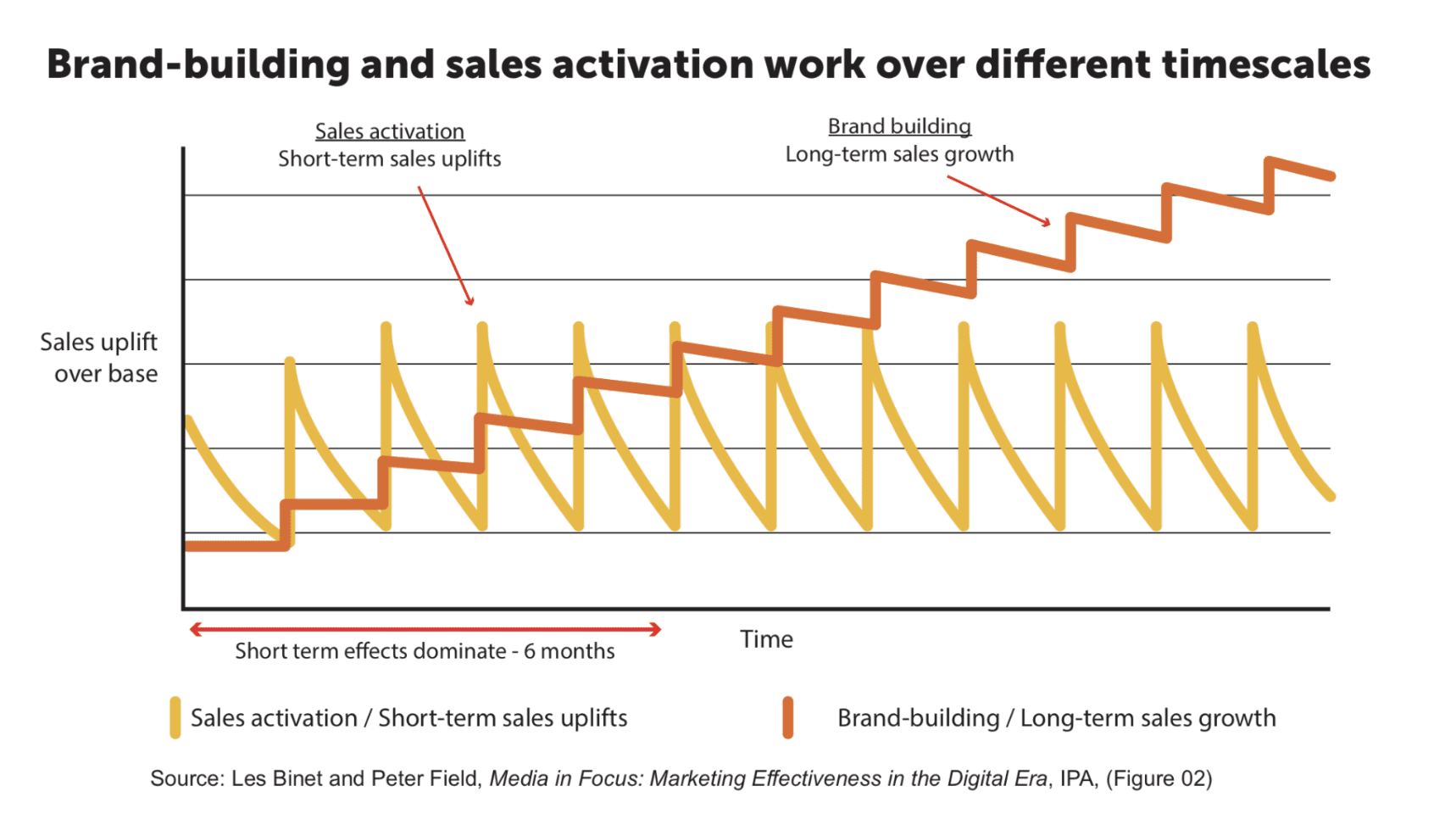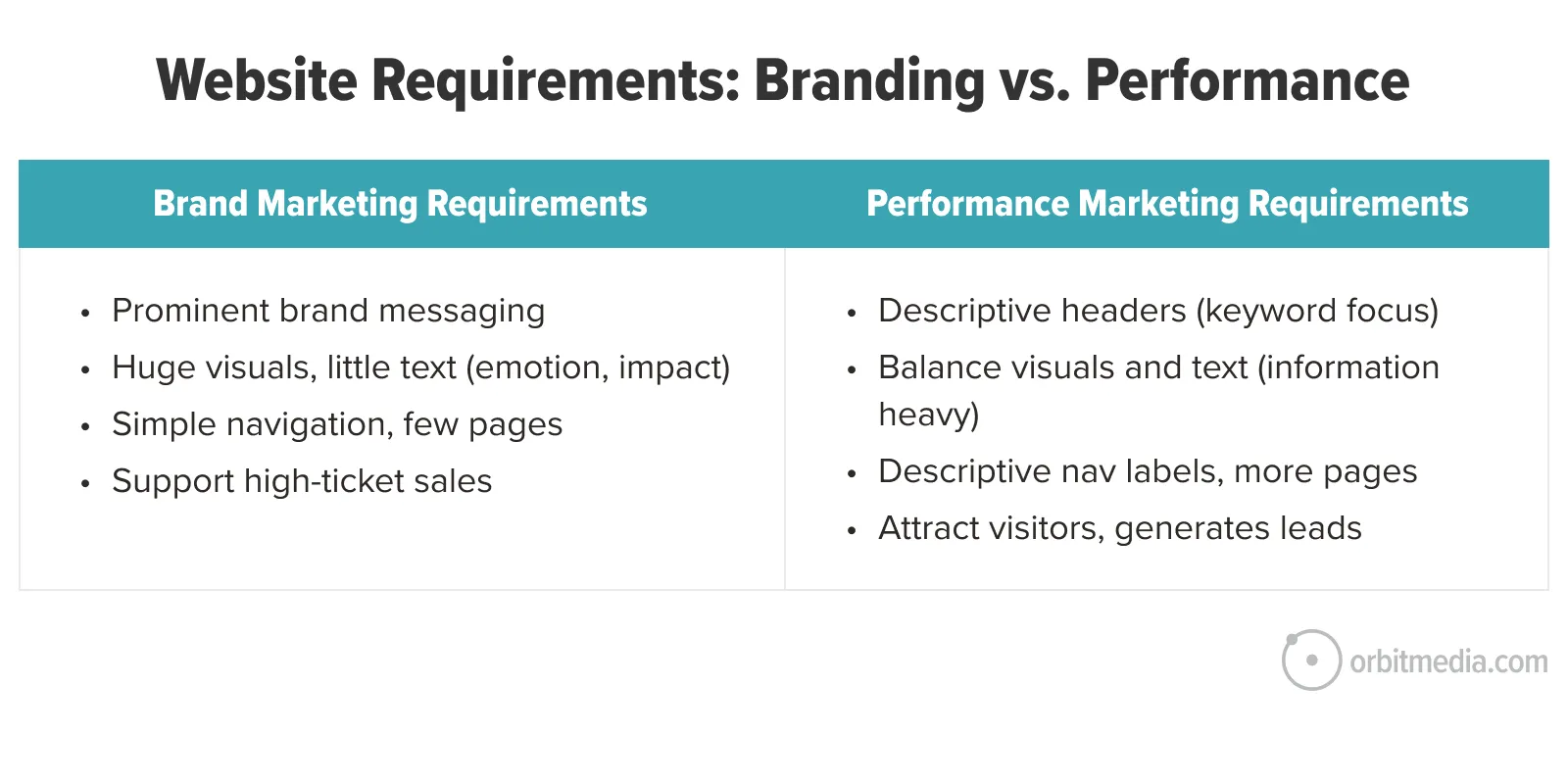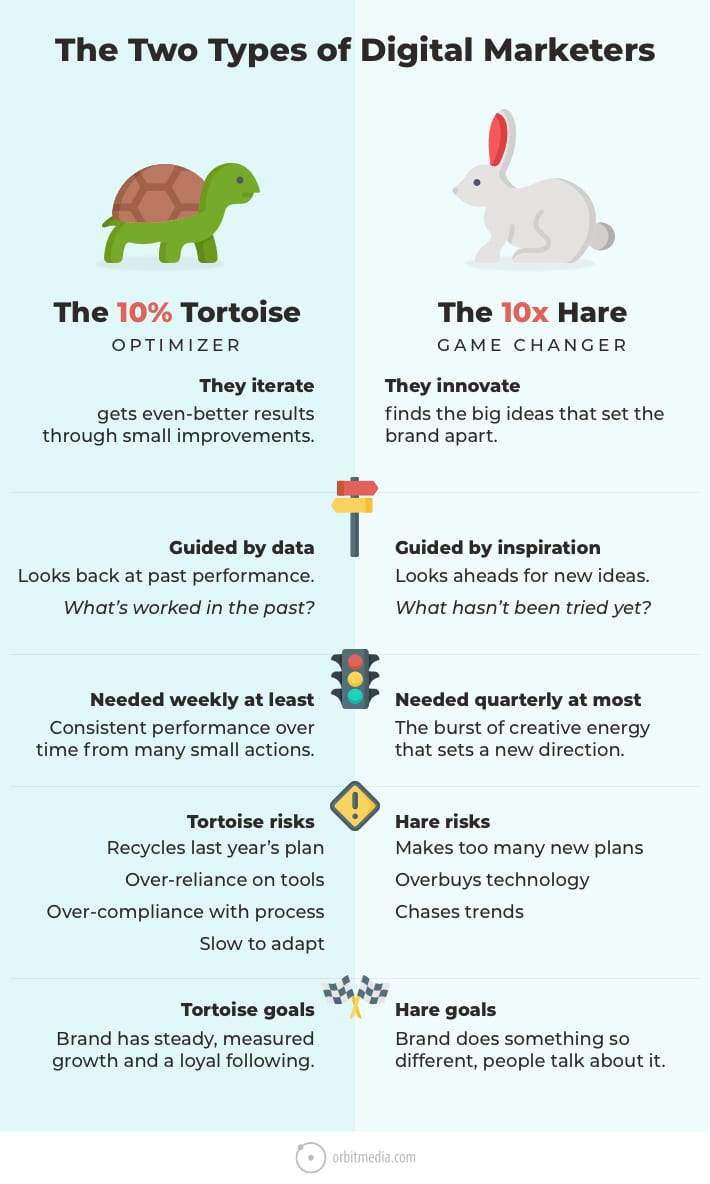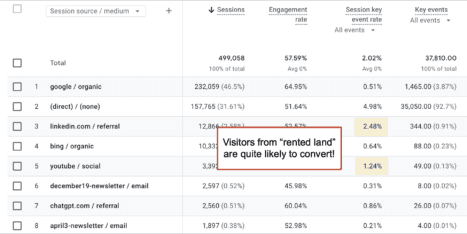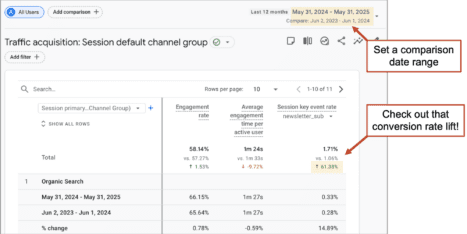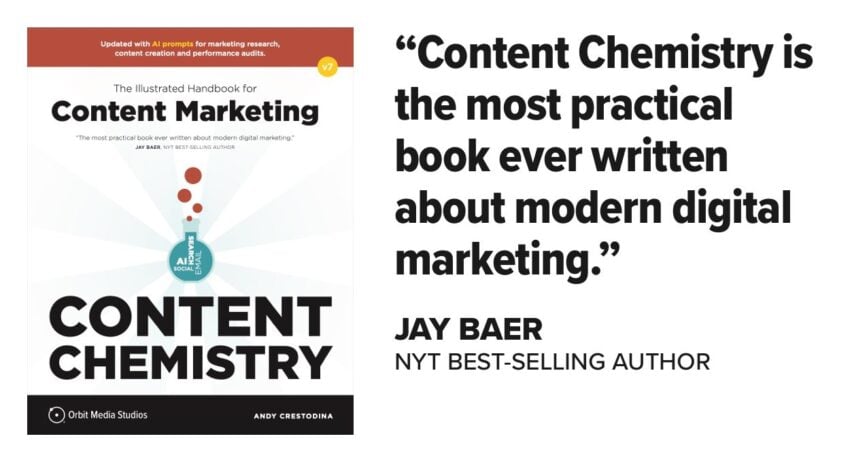There are mostly just two types of marketing.
Brand marketing and performance marketing are very different. They have different goals, strategies, timescales and metrics. Brand marketing seeks to reach as many in-target people as possible as often as possible. Performance marketing seeks to trigger measurable impact in the moment. Very different goals, targets, strategies and metrics.
But all marketing efforts, branding and performance, involve some mix of paid media, earned media and owned media.
From TV ads to webinars, blog posts to Instagram ads, everything is either branding or performance; everything is paid, earned or owned.
Let’s make a chart with branding and performance as columns and all of the channels as rows. We’ll also add sections for goals, targeting and metrics.
Note: In agency circles, “performance marketing” also refers to a pricing model where the agency is paid a percentage of revenue. In this article, we’re using the term to describe the marketing approach, not the compensation structure.
No one “wins” in this comparison. This isn’t a contest. It’s a way to see the bigger picture. The best brands combine brand marketing with performance marketing. In a balanced framework, each makes the other more efficient and effective.
Brand building is a long-term job that requires repeat exposure, while performance marketing focuses on people who are considering options. It exploits brand equity to trigger action in the moment. Strong brands get higher response rates in performance channels.
- Too much brand marketing and you’ll have high general awareness, but you may miss the prospect in the key moment. They searched and didn’t find you in the mix. Or they thought of you, but they can’t quite tell if you’re a fit. Organic traffic and conversion rates are low.
- Too much performance marketing and you drive leads, but you might be forever hooked on high acquisition costs. There is no baseline of awareness and trust. You’re always competing for (even paying for) the next click. Direct traffic is low and CPA is high.
 |
Joe Chernov, Battery“Show me a company with runaway demand gen costs and I’ll show you a company with limited brand awareness.” |
Brands need both. Brand marketing and performance marketing support each other. One builds awareness and trust, which makes all performance channels more efficient.
In 2017, Les Binet and Peter Field analyzed a huge amount of marketing data, and published a report comparing the impact of brand marketing and performance marketing, which they call “sales activation.” They show that brand marketing is slow, but has long term benefits. Performance marketing may get quick results, but they’re often short lived.
The main conclusion of their report is that the most successful brands combine both brand and performance marketing.
“Firms that spend too little on brand building fail to build up brand equity, and so get poor responses from their activation. Firms that spend too little on activation can build strong brands yet fail to exploit them to the full.”
But what’s the right mix? Biney and Field’s data suggest that the right mix is 60% brand marketing and 40% performance marketing, with brand effects kicking in after six months. However, the data includes large consumer brands with big budgets for TV ads. But TV isn’t for everyone.
 |
Paul Boruta, Slingwave“Brand and performance are two gears in the same machine – one builds equity, the other extracts it. Growth comes from orchestrating both.” |
Let’s look at the brand/performance split across marketing channels: paid, earned and owned.
Paid media channels for branding and performance
Any advertising that creates awareness without action is brand marketing. Broadcast, out of home (OOH) and print media are the classic examples. Ads that seek to capture demand in the moment are performance marketing. Google Ads are the classic example.
- Brand marketers don’t expect attribution for advertising. The goal is reach and market penetration. They don’t even try to measure direct ROI.
- Performance marketers expect attribution for paid spend. They use dashboards that show funnel metrics, but those don’t show the value of the brand.
The branding benefit of digital ads
If impressions are brand visibility, then PPC is also a brand marketing channel. If your ad is seen at the top of search results, your brand is visible, even if they didn’t click. Of course, paid search is considered a performance channel, so branding benefits are never measured. Impressions aren’t considered valuable.
Paid social ads have the same benefit. The ad was intended to be clicked and a low clickthrough rate is bad. But if the brand is in the ad, then the impression builds awareness, even if the user scrolled past.
Earned media channels for branding and performance
Some attention, money can’t buy. This includes press mentions, word of mouth marketing and getting recommended by AI.
These channels are some of the most powerful for building trust, not just awareness. They do this through the “halo effect.” When your brand appears within the content of others (media publication, influencer content, reviews, AI responses) the audience trusts it. Earned media lends their credibility to your brand.
AI is a branding channel
The methods for getting AI to mention a brand are still unclear (but we recommend starting with these three steps). Many marketers aren’t even tracking traffic and leads from AI sources (but this video shows you how). Some SEO tools are reporting on visibility and sentiment. But those are brand marketing metrics, not performance metrics.
AI is emerging as a brand marketing earned media channel. It’s word of (an artificial) mouth, with share of (an artificial) voice. The goal is to be top of (an artificial) mind. Sounds like brand marketing, doesn’t it?
Brand marketers aren’t well suited to marketing in this new channel. They don’t generally think about language precision, structured content and clear category signaling. But this is exactly what influences language models. Tag lines aren’t good AI training data.
 |
Mike King, iPullRank“Search has shifted from being a pure performance channel to being a branding channel. AI isn’t just surfacing links, it’s making recommendations and that means your brand equity decides whether you show up. Most marketers aren’t ready for that reality, but it’s an enormous opportunity.” |
Owned media channels for branding and performance
It’s the marketing you own. Your website, your content, your email list, your show. Binet and Field showed the power of owned media in their dataset and included this in their report.
“Owned and earned media are now regarded as much more important elements in the marketing mix, with some suggesting that they may one day displace paid channels entirely.”
Let’s look closer at two aspects of owned media: content marketing and the website itself:
Content marketing is brand marketing
Even though content marketers think a lot about performance, content is really about brand building. It builds awareness and trust with an audience that is not yet in-marketing.
Consider the ways in which content aligns more with brand marketing than performance marketing:
- It’s broad targeting. Like other brand marketing channels, it reaches lots of people who are outside your target.
- Creativity matters. Content that is highly differentiated (original research, thought leadership) reaches farther and is more memorable. 10x content gets 100x results.
- It requires persistence. Only differentiated content, published consistently over time makes the brand memorable.
- It’s low cost. Content marketing is the lowest cost brand marketing play of all time. No big media buying budgets are required. Quality content, promoted well can drive tons of awareness over time.
Our content at Orbit (and on our LinkedIn newsletter) is a branding play. It reaches 50k readers on average per edition. These articles take 10-15 hours to create, including editing and design (thanks Amanda and Jantzen!) which is a big time investment but costs no incremental dollars. Of course, readers aren’t looking for our services. But most of our leads tell us “I’ve been reading your articles for years.”
Broad reach, persistent visibility that keep you top-of-mind with low out-of-pocket costs. Content checks all of the brand marketing boxes. But because content metrics overlap with many performance metrics (shares, downloads, organic traffic) many content marketers don’t think of their efforts as brand marketing.
Yes, some content is all about performance. Bottom-of-funnel content supports sales directly by defeating objections, building confidence and showing extreme levels of expertise. Here are a few examples of content and how it’s used for lead gen and sales:
- Case studies that show the impact of the work (higher conversion rates)
- Industry reports that fuel email nurture sequences (keeping leads warm)
- Buyer guides that are shared with prospects directly (higher sales closing rates)
 |
Jessica Best, Better Ave“I’m pretty biased towards measurable marketing, but if you look at the whole mix, the data tells us it almost takes both to get the best results. Some channels are better suited to brand marketing vs performance marketing (or vice versa) but many can be used to do both, depending on the content or targeting tactics. Email marketing is a really powerful performance marketing channel… But it’s also great for educating audiences that aren’t ready to buy or those who have already bought (👋 newsletters!) for both acquisition and retention…” |
The website… Where brand and performance meet
Every website is both branding and performance marketing. Every website balances the tension between the two.
Ever written the header for a homepage? Did you use a clever brand message? Or a keyphrase that simply names your category? You are feeling the brand vs. performance tension.
At Orbit Media, we strike this balance on 30+ website projects per year. We are 100% focused on web development and website optimization. So walking that wire is our whole world. Here are a few observations from 1000+ projects:
For some website projects, the website is primarily a home for the brand.
Emotion is more important than clarity. There are low expectations for lead generation. Most of the traffic is direct (word-of-mouth, sales support, PR, offline campaigns) They may be successful branding tools, but these sites underperform in search and lead generation.
For other website projects, the client expects to drive leads.
Clarity is more important than emotion. Expectations for lead generation are high. Keyphrase relevance attracts qualified visitors. Conversion copywriting guides them to make a decision in the moment. These sites drive measurable impact. But the brand marketer may not see the emotion they expect from a brand piece.
We’ll show the tension side-by-side in a single chart:
Performance-focused websites have an advantage in the AI responses. A performance-focused website has more pages and more detailed content. They offer the models far more training data and better chances of getting recommended in responses.
We generally recommend prioritizing performance. Every pixel needs to align with the brand, but don’t sacrifice organic lead generation for beauty and emotion. Short pages with little text may feel more brand aligned, but for the high-consideration visitor, they might not find what they’re looking for. They might not find you at all.
A clearly written, well-structured and well-designed website makes any brand more credible, even if the site is search optimized and the copy is conversion focused.
Perhaps I’m biased. Which brings me to our final perspective…
Beware of your own marketing biases
We all have our favorite channels. We all trust the tactics that give us our most reliable wins. But marketing strategy comes first. It comes before SEO and PPC. It comes before content strategy and media budgets. The first question should be, do we have the right mix of brand marketing and performance marketing?
To answer this question, we need to see our own biases so we can set them aside.
- Performance marketers have funnel vision. They know how to drive action and measure it. They keep trying to optimize even when the brand lacks basic levels of trust or awareness. They may be underinvesting in branding efforts. It’s unsatisfying to do marketing that can’t easily be measured.
- Brand marketers have performance blind spots. They use their budgets to be more visible, knowing it’s what healthy brands do. Eat your vegetables, go to the gym and advertise. But they risk putting vague, overly branded messages into performance channels, missing SEO opportunities and hurting conversion rates.
 |
Danny Schuman, Twist Your Thinking“Branding and content marketing are more alike than you might think. Both are investments where you don’t necessarily see bottom line results right away. You can measure affinity and awareness but one of the most important purposes is to get someone to notice you, think about you, talk about you.“ |
The best marketers know their offer, their audience and themselves.
When you meet a marketer, you can quickly tell if they are a brand or performance marketer with just a few quick questions. What channels do you focus on? What do you measure?
We once did a little breakdown of these two types of marketers in our Tortoise vs. Hare Comparison article. This little infographic shows how the skillsets and mindsets of marketers differ wildly.
Brand gets you remembered. Performance gets you chosen. The best marketers don’t pick a side. They know that branding earns attention and performance converts that attention into demand.


